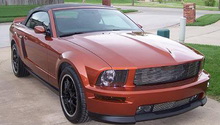Ford Mustang V6 2005-2014: Why is My Car Vibrating?
Whether your Mustang vibrates at low speeds or high speeds, upon starting the engine, or when you use the A/C, finding the cause is a little like having a stomach ache and going to see your doctor. There could be many different causes for your situation. This article will help you diagnose the root of the problem.
This article applies to the Ford Mustang V6 (2005-2014).
When you drive, the ride should feel smooth and not like you're driving down a cobblestone street with potholes. If your Mustang vibrates when you drive it, the reason could be one or more of several issues. This is a problem you can troubleshoot and, in some cases, repair yourself. To help you isolate the problem, and to give you some ideas as to what to do, you need to identify when and where the vibrating starts and stops. This article will help you find major issues and give you some hints on how to eliminate that bothersome problem.

Materials Needed
- Jack and stands
- Flashlight
Step 1 – Car vibrates at speed
Think about how fast your tires are rotating when you're cruising on the interstate. If the tire is out of balance, it can be amplified by speed and more noticeable at higher speeds. It's something like putting one sneaker in the spin cycle of a washing machine. You may need your wheels balanced.
Another thing to check is whether or not the balancing weights on the wheel are missing. Chances are that the last time you had them balanced, the technician attached small weights to the wheel to perfect the balanced rotation of the tire. Most tires mounted on alloy wheels use adhesive backed weights rather than the old weights that were clamped between the wheel and the tire's rim.

If you've been pounding potholes, or are known to hit the occasional curb when parking, then there's a chance that your wheel is slightly bent. This will also cause your car to vibrate at speed. If that's the case, there are companies who specialize in repairing alloy wheels.

Yet another possible cause of vibration could be a loose nut on your driveshaft. At 60 MPH, your driveshaft is spinning at over twice the speed of the wheels. Check the nuts at the front and rear of the driveshaft to see if they are loose. If they are, tighten them and see if the vibrating stops.

Step 2 – Car vibrates upon startup
Metal expands when it's hot and contracts when it's cold. After driving for a while, your exhaust pipes and muffler can reach temperatures in excess of 500 degrees. When the car is parked and the engine is off, the temperature will return to approximately that of the surrounding air. The expanding metal of your exhaust system puts a lot of pressure on the brackets holding it to the underside of your car. As the system cools down, small gaps can appear between the system and the brackets. When the car is started, the stretched brackets allow the exhaust pipes to rattle around until the heat expands the pipes tight against the brackets. Check the brackets to see if they need to be tightened.

Step 3 – Car vibrates when A/C is turned on
Some owners have experienced a vibrating in their cars when they turn the A/C on. If your A/C system is low on refrigerant, the the engine will idle rough, causing the car to vibrate. Unless you know what you're doing, you should have a mechanic check and recharge the system.
Alternatively, cranking up the A/C is a known way to expose rattles and excess chassis vibrations. Some things to check are engine and transmission mounts, as well as brackets or fasteners that may be bolted up to or can rub against the chassis.
Related Discussions
- Rattling/Vibrating Noises Coming From Center Console - MustangForums.com
- Car is Vibrating, Need Help Narrowing It Down - MustangForums.com
- Car is Vibrating and Shaking - MustangForums.com
- Need Help with Vibration and Burning Smell - MustangForums.com
- Vibration When A/C is On - MustangForums.com






